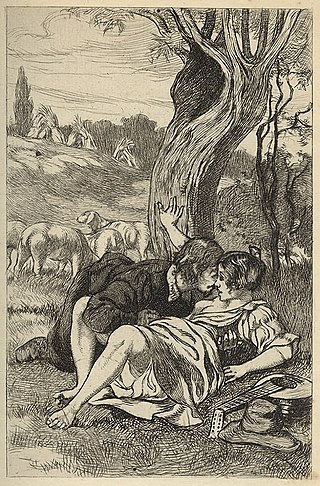
Sexual orientation is an enduring personal pattern of romantic attraction or sexual attraction to persons of the opposite sex or gender, the same sex or gender, or to both sexes or more than one gender. Patterns are generally categorized under heterosexuality, homosexuality, and bisexuality, while asexuality is sometimes identified as the fourth category.

The Kinsey scale, also called the Heterosexual–Homosexual Rating Scale, is used in research to describe a person's sexual orientation based on one's experience or response at a given time. The scale typically ranges from 0, meaning exclusively heterosexual, to a 6, meaning exclusively homosexual. In both the male and female volumes of the Kinsey Reports, an additional grade, listed as "X", indicated "no socio-sexual contacts or reactions" (asexuality). The reports were first published in Sexual Behavior in the Human Male (1948) by Alfred Kinsey, Wardell Pomeroy, and others, and were also prominent in the complementary work Sexual Behavior in the Human Female (1953).

Sexual attraction is attraction on the basis of sexual desire or the quality of arousing such interest. Sexual attractiveness or sex appeal is an individual's ability to attract other people sexually, and is a factor in sexual selection or mate choice. The attraction can be to the physical or other qualities or traits of a person, or to such qualities in the context where they appear. The attraction may be to a person's aesthetics, movements, voice, or smell, among other things. The attraction may be enhanced by a person's adornments, clothing, perfume or hair style. It can be influenced by individual genetic, psychological, or cultural factors, or to other, more amorphous qualities. Sexual attraction is also a response to another person that depends on a combination of the person possessing the traits and on the criteria of the person who is attracted.

The field of psychology has extensively studied homosexuality as a human sexual orientation. The American Psychiatric Association listed homosexuality in the DSM-I in 1952, but that classification came under scrutiny in research funded by the National Institute of Mental Health. That research and subsequent studies consistently failed to produce any empirical or scientific basis for regarding homosexuality as anything other than a natural and normal sexual orientation that is a healthy and positive expression of human sexuality. As a result of this scientific research, the American Psychiatric Association removed homosexuality from the DSM-II in 1973. Upon a thorough review of the scientific data, the American Psychological Association followed in 1975 and also called on all mental health professionals to take the lead in "removing the stigma of mental illness that has long been associated" with homosexuality. In 1993, the National Association of Social Workers adopted the same position as the American Psychiatric Association and the American Psychological Association, in recognition of scientific evidence. The World Health Organization, which listed homosexuality in the ICD-9 in 1977, removed homosexuality from the ICD-10 which was endorsed by the 43rd World Health Assembly on 17 May 1990.
Sexual identity refers to one's self-perception in terms of romantic or sexual attraction towards others, though not mutually exclusive, and can be different to romantic identity. Sexual identity may also refer to sexual orientation identity, which is when people identify or dis-identify with a sexual orientation or choose not to identify with a sexual orientation. Sexual identity and sexual behavior are closely related to sexual orientation, but they are distinguished, with identity referring to an individual's conception of themselves, behavior referring to actual sexual acts performed by the individual, and sexual orientation referring to romantic or sexual attractions toward persons of the opposite sex or gender, the same sex or gender, to both sexes or more than one gender, or to no one.

A sexual fantasy or erotic fantasy is an autoerotic mental image or pattern of thought that stirs a person's sexuality and can create or enhance sexual arousal. A sexual fantasy can be created by the person's imagination or memory, and may be triggered autonomously or by external stimulation such as erotic literature or pornography, a physical object, or sexual attraction to another person. Anything that may give rise to a sexual arousal may also produce a sexual fantasy, and sexual arousal may in turn give rise to fantasies.
The human sexual response cycle is a four-stage model of physiological responses to sexual stimulation, which, in order of their occurrence, are the excitement, plateau, orgasmic, and resolution phases. This physiological response model was first formulated by William H. Masters and Virginia E. Johnson, in their 1966 book Human Sexual Response. Since that time, other models regarding human sexual response have been formulated by several scholars who have criticized certain inaccuracies in the human sexual response cycle model.

Lesbian erotica deals with depictions in the visual arts of lesbianism, which is the expression of female-on-female sexuality. Lesbianism has been a theme in erotic art since at least the time of ancient Rome, and many regard depictions of lesbianism to be erotic.

John Michael Bailey is an American psychologist, behavioral geneticist, and professor at Northwestern University best known for his work on the etiology of sexual orientation and paraphilia. He maintains that male sexual orientation is most likely established in utero.

Sexual attraction to transgender people has been the subject of scientific study and social commentary. Psychologists have researched sexual attraction toward trans women, trans men, cross dressers, non-binary people, and a combination of these. Publications in the field of transgender studies have investigated the attraction transgender individuals can feel for each other. The people who feel this attraction to transgender people name their attraction in different ways.
Human male sexuality encompasses a wide variety of feelings and behaviors. Men's feelings of attraction may be caused by various physical and social traits of their potential partner. Men's sexual behavior can be affected by many factors, including evolved predispositions, individual personality, upbringing, and culture. While most men are heterosexual, there are minorities of homosexual men and varying degrees of bisexual men.
The American-Canadian sexologist Ray Blanchard proposed a psychological typology of gender dysphoria, transsexualism, and fetishistic transvestism in a series of academic papers through the 1980s and 1990s. Building on the work of earlier researchers, including his colleague Kurt Freund, Blanchard categorized trans women into two groups: homosexual transsexuals who are attracted exclusively to men and are feminine in both behavior and appearance; and autogynephilic transsexuals who experience sexual arousal at the idea of having a female body. Blanchard and his supporters argue that the typology explains differences between the two groups in childhood gender nonconformity, sexual orientation, history of sexual fetishism, and age of transition.

Sexuality in transgender individuals encompasses all the issues of sexuality of other groups, including establishing a sexual identity, learning to deal with one's sexual needs, and finding a partner, but may be complicated by issues of gender dysphoria, side effects of surgery, physiological and emotional effects of hormone replacement therapy, psychological aspects of expressing sexuality after medical transition, or social aspects of expressing their gender.

The questioning of one's sexual orientation, sexual identity, gender, or all three is a process of exploration by people who may be unsure, still exploring, or concerned about applying a social label to themselves for various reasons. The letter "Q" is sometimes added to the end of the acronym LGBT ; the "Q" can refer to either queer or questioning.

Sexual activities involving women who have sex with women (WSW), regardless of their sexual orientation or sexual identity, can include oral sex, manual sex, or tribadism.

Human female sexuality encompasses a broad range of behaviors and processes, including female sexual identity and sexual behavior, the physiological, psychological, social, cultural, political, and spiritual or religious aspects of sexual activity. Various aspects and dimensions of female sexuality, as a part of human sexuality, have also been addressed by principles of ethics, morality, and theology. In almost any historical era and culture, the arts, including literary and visual arts, as well as popular culture, present a substantial portion of a given society's views on human sexuality, which includes both implicit (covert) and explicit (overt) aspects and manifestations of feminine sexuality and behavior.

Bisexuality is a romantic or sexual attraction or behavior toward both males and females, to more than one gender, or to both people of the same gender and different genders. It may also be defined to include romantic or sexual attraction to people regardless of their sex or gender identity, which is also known as pansexuality.
Sexual fluidity is one or more changes in sexuality or sexual identity. Sexual orientation is stable and unchanging for the vast majority of people, but some research indicates that some people may experience change in their sexual orientation, and this is slightly more likely for women than for men. There is no scientific evidence that sexual orientation can be changed through psychotherapy. Sexual identity can change throughout an individual's life, and does not have to align with biological sex, sexual behavior, or actual sexual orientation.

Sexual arousal describes the physiological and psychological responses in preparation for sexual intercourse or when exposed to sexual stimuli. A number of physiological responses occur in the body and mind as preparation for sexual intercourse, and continue during intercourse. Male arousal will lead to an erection, and in female arousal, the body's response is engorged sexual tissues such as nipples, clitoris, vaginal walls, and vaginal lubrication.
Erotic plasticity is the degree to which one's sex drive can be changed by cultural or social factors. Someone has "high erotic plasticity" when their sex drives can be affected by situational, social and cultural influences, whereas someone with "low erotic plasticity" has a sex drive that is relatively rigid and unsusceptible to change. Since social psychologist Roy Baumeister coined the term in 2000, only two studies directly assessing erotic plasticity have been completed as of 2010.









